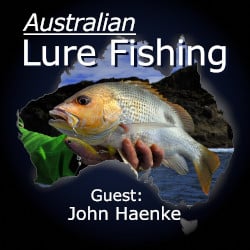

 John Haenke
John Haenke
Fishing Video Producer and Guide
John Haenke is well known for his television and DVD fishing productions such as “Escape with ET”, “Wildfish With Peter Morse” and the “Fishing Downunder” series. But he’s an exceptional angler in his own right – when he’s not busy filming Australia’s fishing elite. John also runs a boutique and very personal guiding service out of Rockhampton for barramundi, king threadfin and a multitude of other species.
John’s Top Tips For Yeppoon Headland Fishing
- The headlands and islands around Yeppoon and the broader central Queensland coast can produce amazing pelagic and reef fishing on lures, all in the same trip.
- Tides and weather are everything for this style of fishing – and the central Queensland coast can get some pretty big tides, as well as ocean swells that can come through a gap in the reef even when there is very little wind.
- The pelagic fishing is best where there are strong tidal currents interrupted by rocky headlands or islands, especially if there is a homie or reef of the headland that creates a deeper channel. Pelagic fish often aggregate on the down current side waiting for bait to funnel through the channel. Position your boat using spot lock to enable casts across the current where possible.
- Reef species can be taken in deeper water in close proximity to the headlands and are best targeted on the smaller tides or when the tide is slowing around the top and bottom.
- Mackerel can be a problem when fishing lures more slowly or jigging, with lure losses common. Switching to wire trace usually results in far fewer bites. It’s better to either switch to high speed metal lures, which tend to hook mackerel in the lips – or switch spots if other species are the target.
- It’s not important to match the hatch regarding the size of lures and fish in these areas are rarely leader shy – sticking to 65g metal lures gives long casting and plenty of bites. Stickbaits and poppers can be used when pelagics are the target but John finds they often get lost or destroyed. Metal lures are equally effective, untreatable, less likely to get snipped off and cheaper when they’re lost.
John’s Headland Fishing Tackle
- For pelagics, a longer spin rod of 7’6” or 8” and 15kg braid allows for longer casts, particularly if there is a swell making it too dangerous to get close to the fish. John generally uses a 50lb fluorocarbon leader, but will increase that to 80lb or more if larger GT’s are on the cards.
- For the ref species John uses a slightly shorter rod, of 6’6” or 7’, once again of 15kg line class.
- Reels for both pelagics and ref species are 4500 size unless big GT’s are about, in which case a 6500 size reel is preferred. Quality reels that are capable of imparting plenty of drag pressure are critical.
John’s Best Headland Fishing Lures
- For pelagics, metal lures in the 65g size range such as Raiders, Taipans and the like are perfect and less expensive than stickbaits and poppers. Switching over to inline hooks and working the lures quickly is effective on Spanish mackerel, tuna, queen fish, trevally, and other species working the bait schools around the headlands.
- For the reef species, 40g soft vibration baits such as the Zerek Fishtrap, Jackall Transams and other quality equivalents work well. John particularly likes the soft vibration baits from Berkley with paddle tails as they swim well on the drop as well as when they’re being worked. It’s sometimes necessary to upgrade the stock hooks with strong, fine gauge trebles from Owner, Decoy or Mustad. Be prepared to experiment with the retrieve technique as different techniques work on different species or different days, it’s typically more of a vertical, jigging retrieve than a horizontal one, but don’t hesitate to cast long and slow roll them back.

 John Haenke
John Haenke
0 Comments